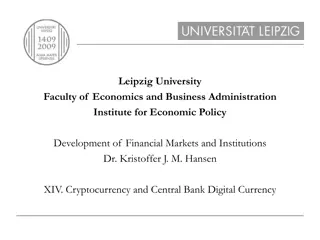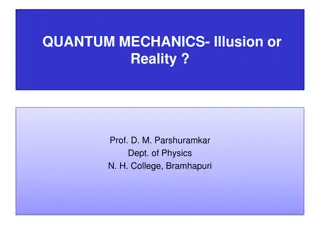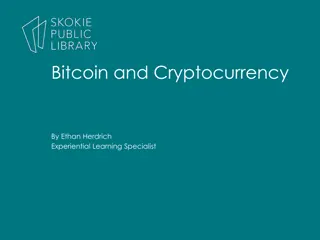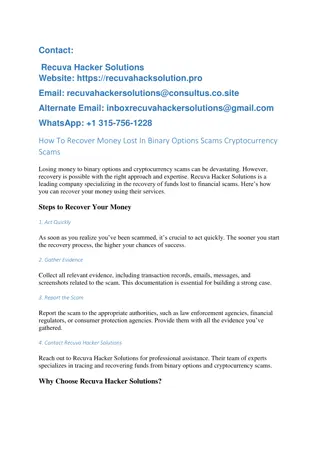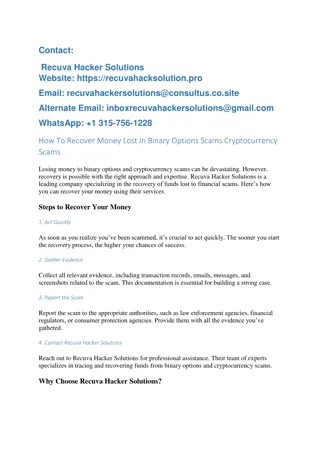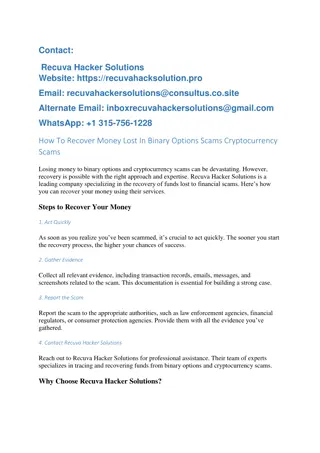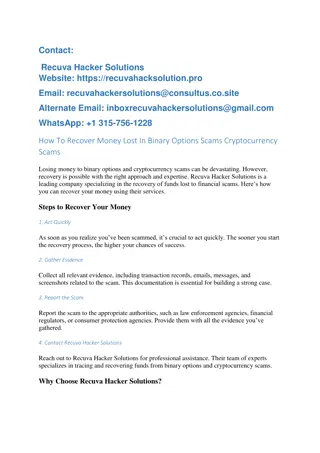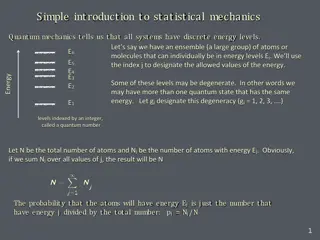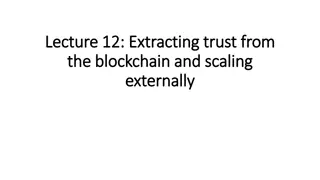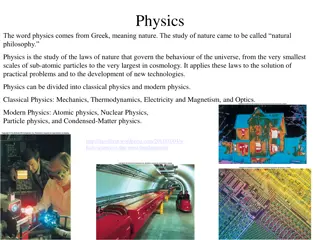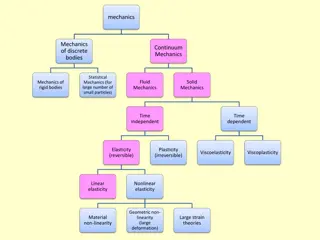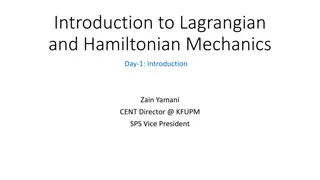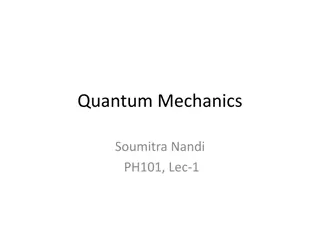Bitcoin Mechanics
Reminder for CS251.Fall.2023 students to check the course website for Project #1 details. Due on Oct. 4.
Download Presentation

Please find below an Image/Link to download the presentation.
The content on the website is provided AS IS for your information and personal use only. It may not be sold, licensed, or shared on other websites without obtaining consent from the author.If you encounter any issues during the download, it is possible that the publisher has removed the file from their server.
You are allowed to download the files provided on this website for personal or commercial use, subject to the condition that they are used lawfully. All files are the property of their respective owners.
The content on the website is provided AS IS for your information and personal use only. It may not be sold, licensed, or shared on other websites without obtaining consent from the author.
E N D
Presentation Transcript
CS251 Fall 2023 (cs251.stanford.edu) Bitcoin Mechanics Dan Boneh Reminder: proj #1 is posted on the course web site. Due Oct. 4
Recap (1) SHA256: a collision resistant hash function that outputs 32-byte hash values Applications: a binding commitment to one value: commit(?) H(?) or to a list of values: commit(?1, ,??) Merkle(?1, ,??) Proof of work with difficulty D: given ? find ? s.t. ?(?,?) < 2256/? takes time ?(?)
Digital Signatures Physical signatures: bind transaction to author Bob agrees to pay Alice 1$ Bob agrees to pay Alice 100$ Problem in the digital world: anyone can copy Bob s signature from one doc to another
Digital signatures Solution: make signature depend on document Signer Verifier accept or reject Bob agrees to pay Alice 1$ verifier signature signing algorithm public verification key (pk) secret signing key (sk)
Digital signatures: syntax Def: a signature scheme is a triple of algorithms: Gen(): outputs a key pair (pk, sk) Sign(sk, msg) outputs sig. Verify(pk, msg, ) outputs accept or reject Secure signatures: (informal) Adversary who sees signatures on many messages of his choice, cannot forge a signature on a new message.
Families of signature schemes 1. RSA signatures (old not used in blockchains): long sigs and public keys ( 256 bytes), fast to verify 2. Discrete-log signatures: Schnorr and ECDSA short sigs (48 or 64 bytes) and public key (32 bytes) (Bitcoin, Ethereum) 3. BLS signatures: 48 bytes, aggregatable, easy threshold (Ethereum 2.0, Chia, Dfinity) 4. Post-quantum signatures: long ( 600 bytes) details in CS255
Signatures on the blockchain Signatures are used everywhere: ensure Tx authorization, governance votes, consensus protocol votes. verify Tx verify Tx verify Tx sk1 data signatures sk2 data signatures
In summary Digital signatures: (Gen, Sign, Verify) Gen() (pk, sk), Sign(sk, m) , Verify(pk, m, ) accept/reject signing key verification key
This lecture: Bitcoin mechanics Oct. 2008: paper by Satoshi Nakamoto Jan. 2009: Bitcoin network launched Total market value: Sep. 2023: $528B
This lecture: Bitcoin mechanics user facing tools (cloud servers) applications (DAPPs, smart contracts) Execution engine (blockchain computer) today Sequencer: orders transactions Data Availability / Consensus Layer next week
First: overview of the Bitcoin consensus layer Bitcoin P2P network end users signed Tx skA skB skC typically, miners are connected to eight other peers (anyone can join)
First: overview of the Bitcoin consensus layer mempool miners broadcast received Tx to the P2P network every miner: validates received Tx and stores them in its mempool (unconfirmed Tx) note: miners see all Tx before they are posted on chain Bitcoin P2P network
First: overview of the Bitcoin consensus layer blockchain I am the leader Every 10 minutes: Each miner creates a candidate block from Tx in its mempool a random miner is selected (how: next week), and broadcasts its block to P2P network all miners validate new block Bitcoin P2P network
First: overview of the Bitcoin consensus layer blockchain 6.25 BTC Selected miner is paid 6.25 BTC in coinbase Tx (first Tx in the block) only way new BTC is created block reward halves every four years max 21M BTC (currently 19.6M BTC) note: miner chooses order of Tx in block
Properties (very informal) Next week: Safety / Persistence: to remove a block, need to convince 51% of mining power * Liveness: to block a Tx from being posted, need to convince 51% of mining power ** (some sub 50% censorship attacks, such as feather forks)
Bitcoin blockchain: a sequence of block headers, 80 bytes each genesis block BH3 BH2 BH1 version (4 bytes) prev time bits nonce Tx root (32 bytes) H H H prev prev (32 bytes) (4 bytes) (4 bytes) (4 bytes) Tx root Tx root 80 bytes coinbase Tx coinbase Tx
Bitcoin blockchain: a sequence of block headers, 80 bytes each time: time miner assembled the block. Self reported. (block rejected if too far in past or future) bits: proof of work difficulty nonce: proof of work solution for choosing a leader (next week) Merkle tree: payer can give a short proof that Tx is in the block new block every 10 minutes.
An example Tx data #Tx 1855 2826 1128 2774 2075 2622
Block 648493 (from coinbase Tx) (D) (adjusts every two weeks) (Tx fees given to miner in coinbase Tx)
This lecture View the blockchain as a sequence of Tx (append-only) coinbase Tx
Tx structure (non-coinbase) input[0] input[1] input[2] 32 byte hash TxID out-index ScriptSig seq input: inputs 4 byte index program ignore output[0] output[1] TxID = H(Tx) (excluding witnesses) outputs 8 bytes value ScriptPK output: witnesses (part of input) (segwit) program (4 bytes) locktime #BTC = value/108 earliest block # that can include Tx
Example null locktime TxOut[1] TxIn[0] TxOut[0] Tx1: (funding Tx) 2 ScriptPK 5 ScriptPK 0 input value value UTXO2 UTXO1 UTXO: unspent Tx output TxIn[0] 1 TxOut[1] TxOut[0] 0 TxID ScriptSig Tx2: (spending Tx) output UTXO4 output UTXO3 identifies a UTXO
Example TxOut[1] null locktime TxIn[0] TxOut[0] Tx1: (funding Tx) 2 ScriptPK 5 ScriptPK 0 input value value UTXO2 UTXO1 UTXO: unspent Tx output TxIn[0] 1 TxOut[1] TxOut[0] 0 TxID ScriptSig Tx2: (spending Tx) output UTXO4 output UTXO3 identifies a UTXO
Validating Tx2 program from funding Tx: under what conditions can UTXO be spent Miners check (for each input): 1. The program ScriptSig | ScriptPK returns true 2. TxID | index is in the current UTXO set 3. sum input values sum output values After Tx2 is posted, miners remove UTXO2from UTXO set
An example (block 648493) [2826 Tx] Tx0 6.25 + Tx fees = input (input UTXO value) Tx1 outputs (Tx fee) Tx2 (Tx fee) sum of fees in block added to coinbase Tx
Tx fees Bitcoin average Tx fees in USD (last 60 days, sep. 2023) $2.11 Bitcoin average Tx fees in USD (all time)
All value in Bitcoin is held in UTXOs 130M Sep. 2023: miners need to store 130M UTXOs in memory
Focusing on Tx2: TxInp[0] from UTXO (Bitcoin script) from TxInp[0]
Bitcoin Script A stack machine. Not Turing Complete: no loops. Quick survey of op codes: 1. OP_TRUE (OP_1), OP_2, , OP_16: push value onto stack 81 82 96 2. OP_DUP: push top of stack onto stack 118
Bitcoin Script 3. control: OP_IF <statements> OP_ELSE <statements> OP_ENDIF 99 OP_VERIFY: abort fail if top = false 105 OP_RETURN: abort and fail what is this for? ScriptPK = [OP_RETURN, <data>] 106 OP_EQVERIFY: pop, pop, abort fail if not equal 136
Bitcoin Script 4. arithmetic: OP_ADD, OP_SUB, OP_AND, : pop two items, add, push 5. crypto: OP_SHA256: pop, hash, push OP_CHECKSIG: pop pk, pop sig, verify sig. on Tx, push 0 or 1 6. Time: OP_CheckLockTimeVerify (CLTV): fail if value at the top of stack > Tx locktime value. usage: UTXO can specify min-time when it can be spent
Example: a common script <sig> <pk> DUP HASH256 <pkhash> EQVERIFY CHECKSIG stack: empty init push values DUP HASH256 push value EQVERIFY CHECKSIG verify(pk, Tx, sig) <sig> <pk> <sig> <pk> <pk> <sig> <pk> <hash> <sig> <pk> <hash> <pkhash> <sig> <pk> 1 successful termination
Transaction types: (1) P2PKH pay to public key hash Alice want to pay Bob 5 BTC: step 1: Bob generates sig key pair (pkB, skB) Gen() step 2: Bob computes his Bitcoin address as addrB H(pkB) step 3: Bob sends addrBto Alice step 4: Alice posts Tx: UTXOA for Alice (change) UTXOB for Bob input 7 BTC Point to Alice s UTXO 5 ScriptPKB 2 ScriptPKA 0 ScriptPKB: DUP HASH256 <addrB> EQVERIFY CHECKSIG
Transaction types: (1) P2PKH pay to public key hash input contains ScriptSig that authorizes spending Alice s UTXO example: ScriptSig contains Alice s signature on Tx miners cannot change ScriptPKB (will invalidate Alice s signature) UTXOA for Alice (change) UTXOB for Bob input 7 BTC Point to Alice s UTXO 5 ScriptPKB 2 ScriptPKA 0 ScriptPKB: DUP HASH256 <addrB> EQVERIFY CHECKSIG
Transaction types: (1) P2PKH Later, when Bob wants to spend his UTXO: create a Txspend Txspend: 0 TxID 0 ScriptSigB output output points to UTXOB <sig> <pkB> (authorizes spending UTXOB) <sig> = Sign(skB, Tx) where Tx= (Txspend excluding all ScriptSigs) (SIGHASH_ALL) Miners validate that ScriptSigB | ScriptPKB returns true
P2PKH: comments Alice specifies recipient s pk in UTXOB Recipient s pk is not revealed until UTXO is spent (some security against attacks on pk) Miner cannot change <AddrB> and steal funds: invalidates Alice s signature that created UTXOB
Segregated Witness ECDSA malleability: Given (m, sig) anyone can create (m, sig ) with sig sig miner can change sig in Tx and change TxID = SHA256(Tx) Tx issuer cannot tell what TxID is, until Tx is posted leads to problems and attacks Segregated witness: signature is moved to witness field in Tx TxID = Hash(Tx without witnesses)
Transaction types: (2) P2SH: pay to script hash (pre SegWit in 2017) Let s payer specify a redeem script (instead of just pkhash) Usage: payee publishes hash(redeem script) Bitcoint addr. payer sends funds to that address ScriptPK in UTXO: HASH160 <H(redeem script)> EQUAL ScriptSig to spend: <sig1> <sig2> <sign> <redeem script> payer can specify complex conditions for when UTXO can be spent
P2SH Miner verifies: payee gave correct script (1) <ScriptSig> ScriptPK = true script is satisfied (2) ScriptSig = true
Example P2SH: multisig Goal: spending a UTXO requires t-out-of-n signatures Redeem script for 2-out-of-3: (set by payer) <2> <PK1> <PK2> <PK3> <3> CHECKMULTISIG hash gives P2SH address ScriptSig to spend: (by payee) <0> <sig1> <sig3> <redeem script>
END OF LECTURE Next lecture: interesting scripts, wallets, and how to manage crypto assets


